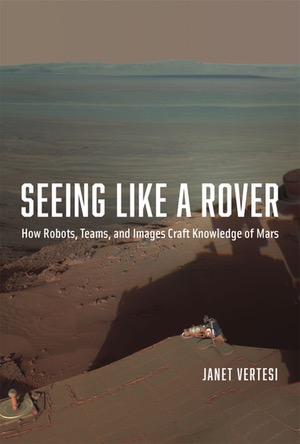Review: Seeing Like A Roverby Jeff Foust
|
| Team members spoke of the need to get as much done as possible given pressures ranging from budgets to what Vertesi called the “constant threat” of a failure by the rovers that would end the mission. “This was colloquially referred to as ‘the sniper,’” she writes. |
By contrast, a Mars rover mission might, at first glance, look positively leisurely. Did a measurement of the composition of a rock fail for some reason? Try it again. Does that outcropping of rock in the distance look interesting? Drive over and take a look. After all, those rocks are not going anywhere any time soon. What’s the rush?
In reality, though, planning the daily activities of a Mars rover can be just as challenging as planning a one-time spacecraft flyby. That’s one of the insights of Seeing Like a Rover by Janet Vertesi, an assistant professor of sociology at Princeton University who was embedded for an extended time with the Mars Exploration Rovers program at JPL. The book offers a fascinating look at both how the mission team operates the rovers, and how scientists work with the data the rovers return.
Vertesi takes the reader into meetings of the rovers’ Science Operations Working Group, where the project team meets to plan the next day’s activities by the rovers (at the time Vertesi did her research, both Spirit and Opportunity were working; only Opportunity operates now.) She provides a glimpse of how the team creates a plan to maximize the science the rover can do on a particular day, given power and communications constraints and the competing demands of scientists seeking to use different instruments. The goal is to develop a plan by consensus that takes into account everyone’s needs: at the end of the meeting, everyone is polled on whether they’re “happy” with the outcome.
That approach allows for adjustments on a day-by-day basis based on the science results and other mission requirements, but the pressure to perform was as high as other planetary missions despite its open-ended nature. Team members spoke of the need to get as much done as possible given pressures ranging from budgets to what Vertesi called the “constant threat” of a failure by the rovers that would end the mission. “This was colloquially referred to as ‘the sniper,’” she writes, “as in the expression ‘the sniper could strike at any time.’” That concern, she said, helped focus the team, “bringing them into alignment with orderly expectations and totemic relations.”
As the title suggests, much of the book examines how rover scientists make use of the images the rovers return: how they’re calibrated and analyzed by scientists, who manipulate the images in different ways, including the use of false color, to bring out different features. Scientists and rover operators alike become attuned to how the rovers’ cameras work, as well as the rest of the spacecraft, almost instinctively understanding the spacecraft’s capabilities and limitations.
While it’s common for people to anthropomorphize spaceraft, imbuing them with human characteristics, Vertesi notes there is also a reverse process at work: people start to take on characteristics of the rovers. At one level, rover operators move their bodies to mimic the rovers’ capabilities, to better understand how to choreograph their movements: “I have witnessed members working through robotic activities with their feet, arms, and eyes to suggest digging trenches with the rovers’ wheels,” she writes.
There’s also a deeper connection, though, to the point of team members experiencing the rovers’ mechanical problems as aches and pains. Even Vertesi, as an observer, noticed it. “It is difficult to express verbally, but I can feel it in my body: a kind of posture or stiffness associated with each robot’s different faults and features, like Spirit’s stuck wheel and Opportunity’s stiff shoulder joint,” she writes.
| “It is difficult to express verbally, but I can feel it in my body: a kind of posture or stiffness associated with each robot’s different faults and features, like Spirit’s stuck wheel and Opportunity’s stiff shoulder joint.” |
Seeing Like a Rover is an interesting look at the people, but not the individuals, involved in the missions and how they work with the rovers and analyze the data. That is to say, we don’t learn much beyond their roles in the mission about the individual people, who are mentioned throughout the book either by their title or by first names (which, the appendix notes, are pseudonyms.) That helps them be more open about the mission, but also keeps them at sort of a distance. And that anonymity has its limits: one can refer to the mission’s principal investigator by solely that title, and meeting at an “Ivy League” university, but it takes little effort to find out that that individual is Steven Squyres of Cornell University.
Another reason for that distance is that Seeing Like a Rover is also an academic treatise: an examination of how scientists use and manipulate images to perform their science. That leads to language like this: “Rather than taking a macro approach to analyzing the politics that enroll state actors and colonial engagements in producing maps of unexplored terrain, a subtle point is evident at the micro scale: that images reflect and project the local social orders and social relations that produce them.” That can be a mouthful for those not steeped in ethnography, sociology, or the history of science, but the book is still a fascinating look inside how a mission operates, working to get the most science out of a mission that has no firm end, and yet could end any day.
